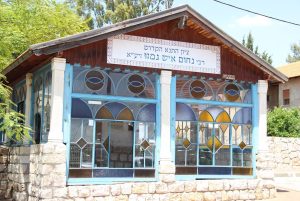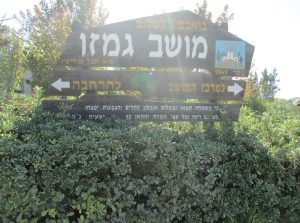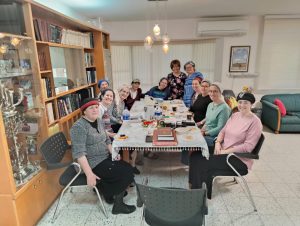Two teachers, two students, two ways of learning Torah. That is what is presented on our daf:
“Rabbi Yishmael served Rabbi Neḥunya ben HaKana, who would interpret the entire Torah with the principle of a generalization and a detail (כלל ופרט) . .. Rabbi Akiva served Naḥum Ish Gamzo, who would interpret the entire Torah with the principle of amplification and restriction. (ריבוי ומיעוט)” (Shevuot 26a)
Rabbi Yishmael, and Rabbi Akiva need no introduction. These two giants of Torah law founded schools and raised a generation of students. But the teachers of these teachers are less well known. Who were Nahum Ish Gamzo and Nehunya ben HaKana?
Both men were Tannaim in the second generation, living and working at the end of the first and the beginning of the second century CE. This was a difficult and transitional time, between the destruction of the Temple and the Bar Kokhba Revolt. Their respective approaches to derash shaped the Oral Law as we know it today.
Nachum studied the language of the Torah very carefully and learned something from each word, he would expound even the smallest word “et” (Hagigah 12a). His student Rabbi Akiva served him for twenty-two years and followed in his footsteps not only in halacha but also in his approach to life, as we shall see. Nahum suffered terribly and when his students asked him why, he explained that he did not help a poor man in time and therefore inadvertently caused his death. He is careful to say that he, Nahum, brought his suffering upon himself as an atonement:
“I went and fell upon his face and said: May my eyes, which had no compassion on your eyes, be blinded; may my hands, which had no compassion on your hands, be amputated; may my legs, which had no compassion on your legs, be amputated. And my mind did not rest until I said: May my whole body be covered in boils.” (Taanit 21a)

The traditional site of Nahum’s grave in Tzfat
קרלוס הגדול, CC BY-SA 3.0 <https://creativecommons.org/licenses/by-sa/3.0>, via Wikimedia Commons
The picture that the Gemara paints of Nahum is of someone who sees God’s hand in the world and also believes that his sufferings will bring him atonement. His curious name is explained later on the same page:
“And why did they call him Naḥum Ish Gamzo? The reason is that with regard to any matter that occurred to him, he would say: This too is for the good [gam zo letova]. Once, the Jews wished to send a gift to the house of the emperor. They said: Who should go and present this gift? Let Naḥum Ish Gamzo go, as he is accustomed to miracles.” (Taanit 21a)
The story goes on to tell of how the treasure was stolen but Elijah miraculously saved Nahum from the wrath of the emperor. This is a classic “miracle done for a righteous person” story but not really an “all for the best” story. For that we need to look at the parallel tale told about Nahum’s disciple, Rabbi Akiva:
“When Rabbi Akiva was walking along the road and came to a certain city, he inquired about lodging and they did not give him any. He said: Everything that God does, He does for the best. He went and slept in a field, and he had with him a rooster, a donkey and a candle. A gust of wind came and extinguished the candle; a cat came and ate the rooster; and a lion came and ate the donkey. He said: Everything that God does, He does for the best. That night, an army came and took the city into captivity. [It turned out that Rabbi Akiva alone, who was not in the city and had no lit candle, noisy rooster or donkey to give away his location, was saved.] He said to them: Didn’t I tell you? Everything that God does, He does for the best.” (Berachot 60b)
While Nahum certainly had deep faith and taught his student Rabbi Akiva to have the same belief in God’s providence, his name probably came from somewhere else and was only later connected to his signature phrase. In Tanakh and in the Mishnah we hear about a town called Gimzo located in the lowlands (shephelah) of Judah:
“And the Philistines made forays against the cities of the Shephelah and the Negeb of Judah; they seized Beth-shemesh and Aijalon and Gederoth, and Soco with its villages, and Timnah with its villages, and Gimzo with its villages; and they settled there.” (Divrei HaYamim II 28:18)
The Mishnah also talks about the fruits of the sycamore tree that are called gimziot, perhaps because they grow near Gimzo. Gimzo was between Lod and Bnei Brak and therefore very centrally located in the time of Nahum and Rabbi Akiva. Gimzo was Nahum’s hometown, and in a nice play on words, he was also the “gamzo” man, the one who says this is all for the best. A similar game is played with Honi haMaagel: his job was probably to use a maagela, a roof flattener, but he also drew an igul, a circle around himself, in the famous story where he brings the rain. His name came to mean both those things.

Modern town of Gimzo
Avi1111 dr. avishai teicher, CC BY-SA 4.0 <https://creativecommons.org/licenses/by-sa/4.0>, via Wikimedia Commons
And what about Rabbi Nehunya, Rabbi Yishmael’s teacher? We do not have too much information about him, but a prayer of his has become very famous in the world of learning:
“Rabbi Neḥunya ben Hakana would recite a brief prayer upon his entrance into the study hall and upon his exit. . . Upon my entrance, I pray that no mishap will transpire by me. And upon my exit, I give thanks for my portion.” (Berachot 4:2)
The Gemara takes this brief prayer and expands upon it and this is what we say on the completion of a masechet:
“Upon his exit, what did he say? I give thanks before You, Lord my God, that You have placed my lot among those who sit in the study hall, and that you have not given me my portion among those who sit idly on street corners. I rise early, and they rise early. I rise early to pursue matters of Torah, and they rise early to pursue frivolous matters. I toil and they toil. I toil and receive a reward, and they toil and do not receive a reward. I run and they run. I run to the life of the World-to-Come and they run to the pit of destruction.” (Berachot 28b)
May we always merit to have the faith of Nahum Ish Gamzo and the dedication to learning of Rabbi Nehunya ben HaKana.

Thank You Hashem, that You have placed my lot among those who sit in the study hall










